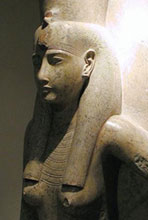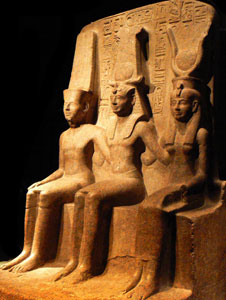

Mut (Maut, Mwt) was the mother goddess of Thebes (Waset, in the 4th Nome of Upper Egypt). The ancient Egyptians considered the vulture to be a protecting and nurturing mother, and so their word for mother was also the word for a vulture, “Mwt”.

Mut was either depicted as a woman, sometimes with wings, or a vulture, usually wearing the crowns of royalty – she was often shown wearing the double crown of Egypt or the vulture headdress of the New Kingdom queens. Occasionally, she was depicted as a male, in part because she was “Mut, Who Giveth Birth, But Was Herself Not Born of Any”, and in part due to the superstitious belief that there were in fact no male griffon vultures (the male is almost identical in appearance to the female). In later times, Mut was depicted as a woman with the head of a lioness, a cow, or a cobra, as she took on the attributes of the other Egyptian goddesses.
Mut replaced Amun’s earlier wife, Amanuet (the invisible goddess) during the middle Kingdom. Mut was believed to have existed since primeval times, existing along side Nun, the primeval waters (possibly because she replaced Amaunet who was one of the ancient gods of the Ogdoad – the great eight – who lived in the waters).
She was initially worshipped as a local deity, but rose to prominence as the queen of the gods when her husband, Amun, became the foremost national god during the New Kingdom. Thebes became the capital of Egypt, and the Theban gods became the national gods. As a result, Mut was also closely associated with the queen, the mother of the nation. She was particularly popular with the queens of the Eighteenth and Nineteenth dynasties, most notably the Pharaoh Hatshepsut and Nefertari Merytnmut (“Nefertari, Beloved of Mut”) the Chief wife of Ramessess II.
When her husband Amun merged with the sun god Ra, as Amun-Ra, Mut inherited the title the “Eye of Ra” (a title also associated with Sekhmet, Hathor, Tefnut, Bast, and Wadjet, among others). The “Eye of Ra” was the daughter of Ra in the form of a lion who embodied the fierce heat of the sun. However, Mut was also “Mother of the Sun in Whom He Rises” – making her both the mother and daughter of the sun god. Originally Montu (the Theban god of war) was considered to be their son, but he was replaced by Khonsu (the moon god).
The Theban triad of Amun, Mut, and Khonsu were worshipped at the Temple of Amun at Luxor (Ipet-Resyt). Although her worship centred around Thebes, she was also worshiped in Djannet (Tanis), Zau (Sais), the Oases of Kharga, and Dakhla.

Mut was also closely associated with a number of other goddesses such as Isis and Nut, and was worshipped as a member of a number of composite deities. With Isis and Nekhbet she formed the deity called “Mut-Isis-Nekhbet, the Great Mother and Lady”. She was a winged goddess with leonine feet, an erect penis and three heads (the head of a lioness wearing Min’s double plumed headdress, the head of a woman wearing the double crown of Egypt, and the head of a vulture wearing the red crown of Lower Egypt).
With Bast and Sekhmet she was Sekhmet-Bast-Ra, another three headed deity (the head of a lion with a plumed headdress, a woman wearing the double crown, and a vulture wearing the double plumed headdress). In this form she is described in the Book of the Dead protecting the dead from being disturbed. She was also worshipped as Mut-Wadjet–Bast, Mut-Temt, and Mut-Sekhmet–Bast–Menhet.
During the New Kingdom, one of the most popular holidays was the Festival of Mut in Thebes. A statue of the goddess was placed on a barque and sailed around the “Isheru” (the small crescent moon shaped sacred lake at her temple at Karnak). There was also a celebration during the New Year festival when the statue of Amun traveled from his temple at Luxor down to Karnak to visit her. Originally, this was for the fertility goddess Opet (possibly an aspect of Taweret), as a way of ensuring fertility for the coming year.
The temple, “Hwt-Mwt” (“the estate of Mut”) was situated to the south of the great temple of Amen-Ra, with an avenue of sphinxes approaching it. She was worshiped there as “Mut, the Great Lady of Isheru, the Lady of Heaven, the Queen of the Gods”. Strangely, there are few representations of her in her vulture form in this temple. However, there are numerous depictions of her as Sekhmet, the “Eye of Ra” – a number of which seem to have been transported from Amenhotep III’s funerary temple on the west bank. It is thought that the temple was initially established by Hatshepsut and Thuthmose III, and then expanded by Seti I, Ramesses II, Ramesses III, and King Tarqa (25th Dynasty). She was worshipped up until the Roman period, when her temple fell into disrepair.
Bibliography
- The Complete Gods and Goddesses of Ancient Egypt (2003) Richard H. Wilkinson
- Egyptian Mythology (1997) Simon Goodenough
- Gods of Ancient Egypt (1996) Barbara Watterson
Copyright J Hill 2015